Try Default

See how revenue teams automate revenue operations with Default.

Key Takeaways
- ZoomInfo is ideal for high-volume RevOps and enterprise sales teams that need advanced enrichment, intent data, and territory segmentation — but it comes with a steep price tag and requires dedicated ops bandwidth to unlock full value.
- RocketReach is best for lean GTM teams or individual contributors who prioritize speed and affordability over workflow depth — great for quick contact lookup, not for scaling inbound.
- Default is purpose-built for inbound GTM teams that want CRM-native enrichment, lead routing, and scheduling — all in one flow. No bolted-on schedulers, no engineering dependency.
- If your goal is pipeline acceleration with operational efficiency, Default closes the gap between cost and capability, offering more automation per dollar than legacy stacks.
Choosing a data enrichment tool sounds straightforward — until you’re knee-deep in Zapier flows, CRM workarounds, and another ops ticket just to fix a routing issue.
Most teams don’t need more data. They need data that actually moves deals forward — and a system that doesn’t slow everything else down.
So, what are your options? And which one actually delivers the most value for your GTM motion in 2025?
Here’s the quick breakdown:
- ZoomInfo is powerful, but heavy — built for scale, with the price and complexity to match.
- RocketReach is fast and affordable — but better suited for quick lookups than repeatable workflows.
- Default brings it all together — a modern, inbound-native platform that connects enrichment, routing, and scheduling in one automated flow.
In this guide, we’ll break down where each tool shines, where they fall short, and how to pick the one that fits your team — not the other way around.
ZoomInfo vs RocketReach: at a glance
Who is ZoomInfo useful for?
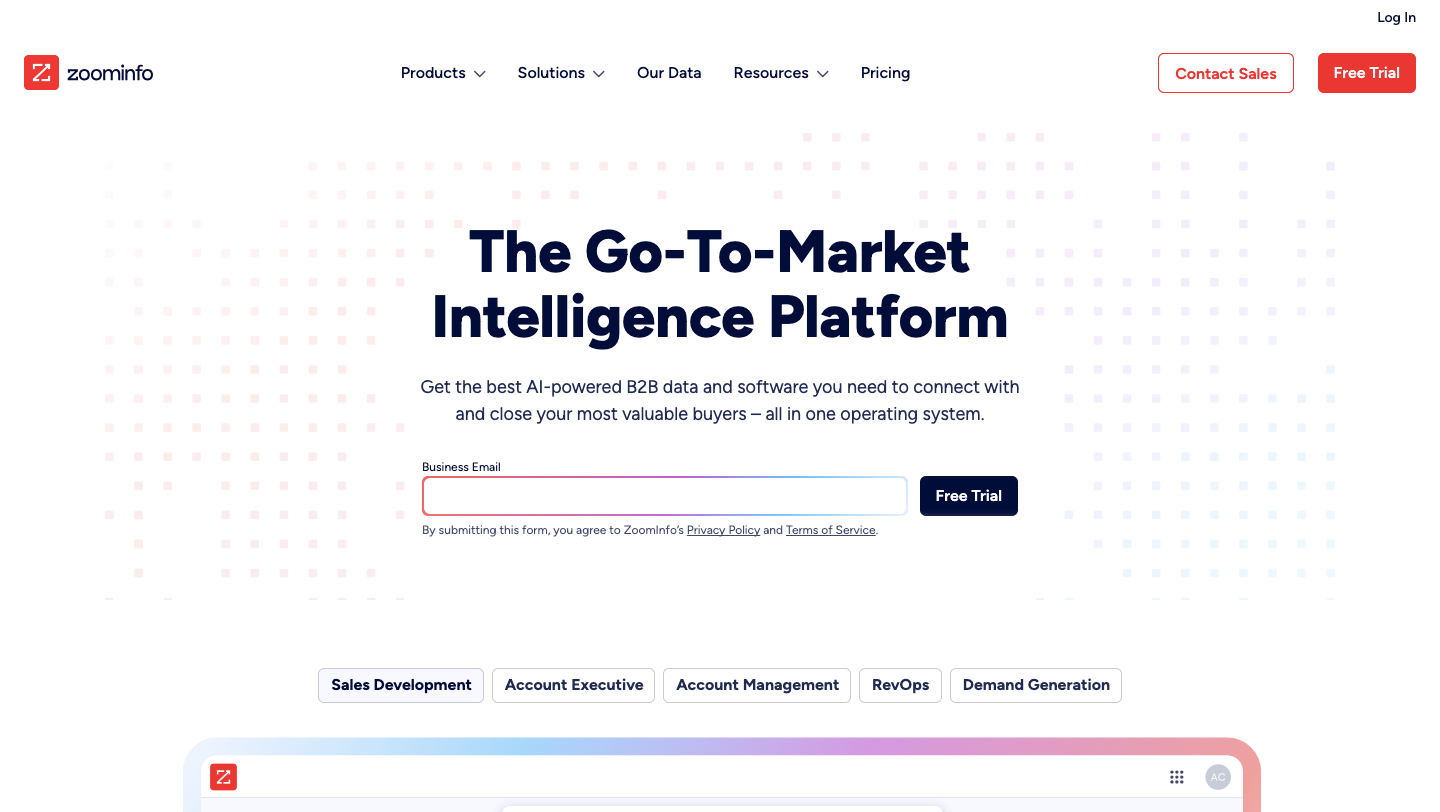
ZoomInfo is best for enterprise RevOps and sales orgs that need high-volume enrichment, real-time intent signals, and deep org mapping to support complex GTM programs.
It’s particularly effective for teams running multi-touch outbound, ABM, and territory-based routing — but only if you have dedicated ops or enablement resources to configure, maintain, and extract full value from the platform.
Who is RocketReach useful for?
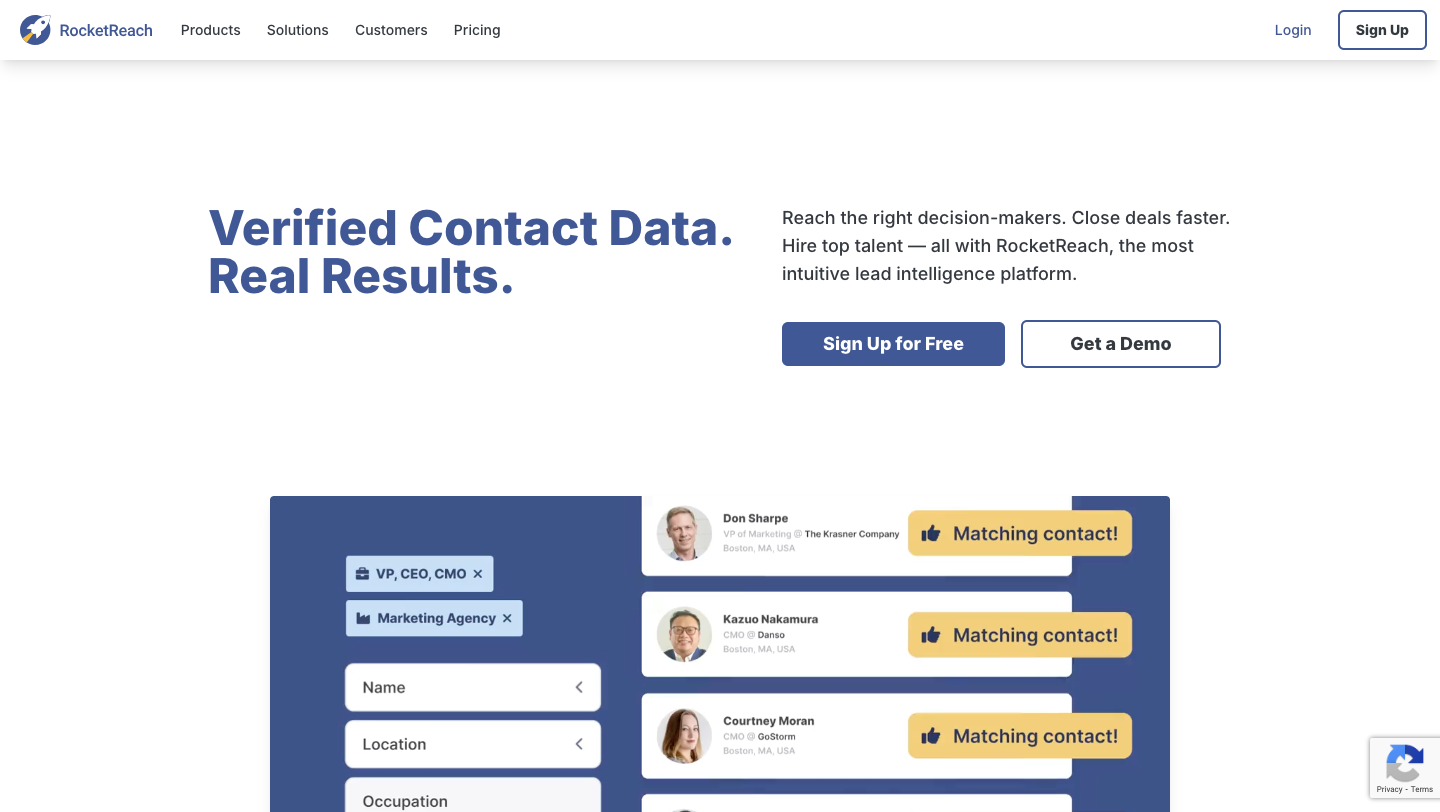
RocketReach is ideal for individual contributors, SDRs, founders, or lean GTM teams that need fast access to verified contact info, without CRM integration or automation overhead.
It works well for teams running manual or ad hoc outreach, but isn’t built to support multi-touch lead journeys or automated workflows. If your team isn't yet investing in RevOps infrastructure, RocketReach offers a simple entry point — but not a long-term system.
Default: an alternative
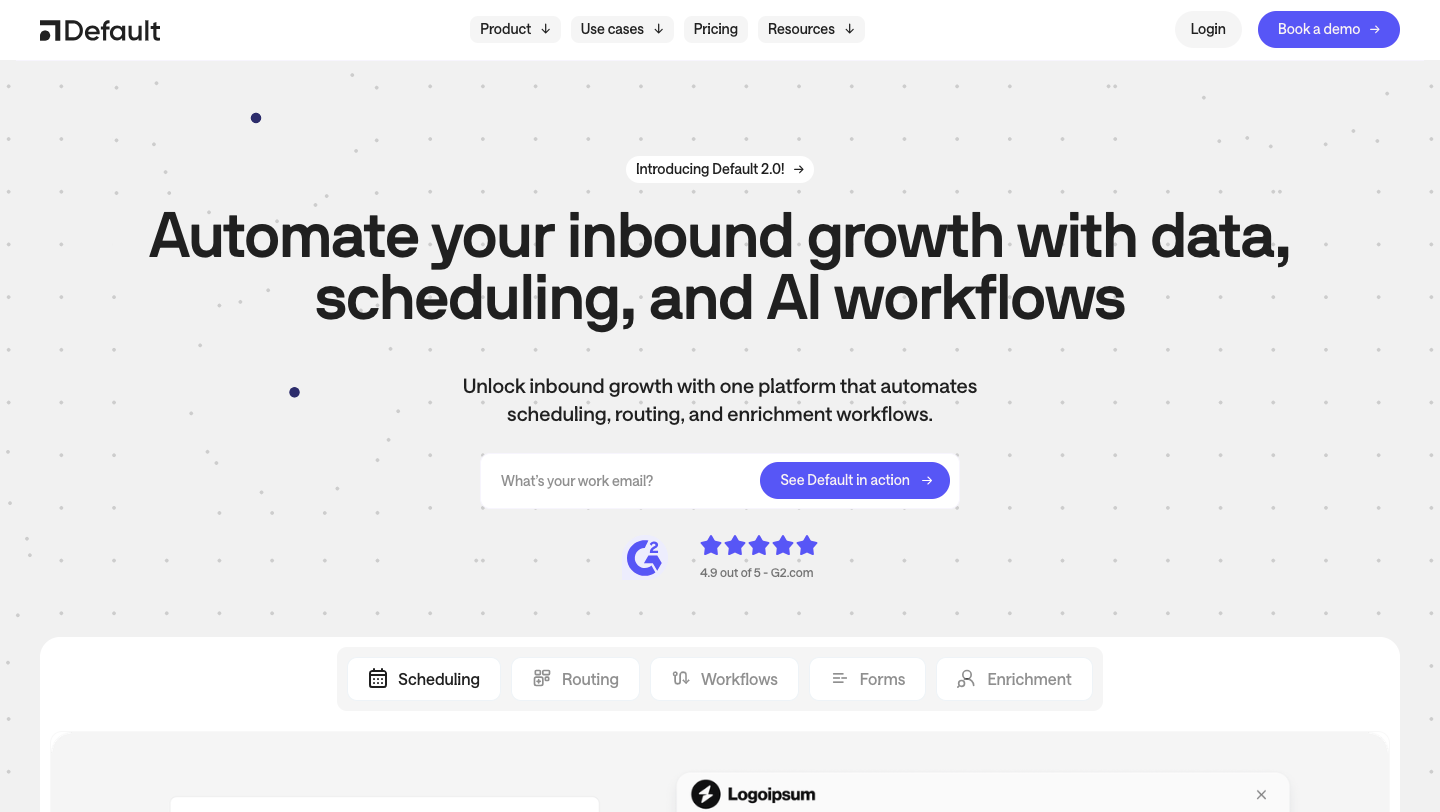
Default is built for inbound GTM teams that want to replace a tangled mess of enrichment tools, form routers, schedulers, and ops hacks with one clean, automated flow.
There’s no middleware, no vendor sprawl, and no engineering dependency. Just a single platform your ops team can manage directly — from routing logic to CRM sync.
Pricing comparison
See how Default simplifies your inbound motion - Get your live demo today.
Pricing plans
When evaluating data enrichment platforms, price tag ≠ true cost. The real question is: How efficiently does each tool turn spend into pipeline?
Some tools charge for every seat, even if they’re not generating revenue. Others hide value behind bundled features. Here's what to expect:
ZoomInfo
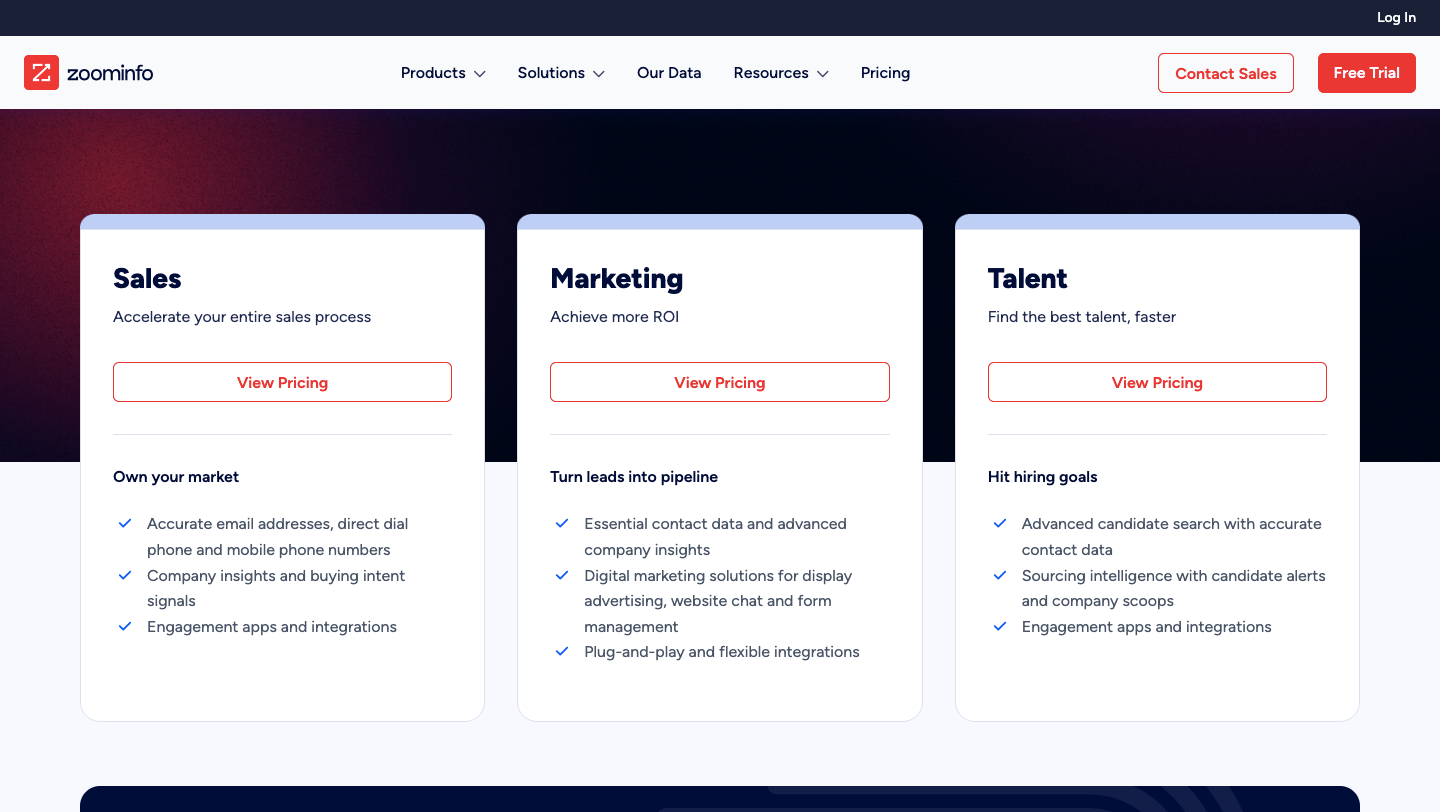
- High entry point: ZoomInfo uses custom pricing for every account, but most small teams start around $15K–$20K/year. Larger orgs often pay much more, depending on seats, feature bundles, and data credits.
- Seat-based pricing: You pay for every user, including managers, ops leads, and even integrations.
- Opaque, bundled pricing: Enrichment, intent, and routing are packaged together, limiting flexibility.
- Surprise add-ons: Want org charts, scoops, or automation? Expect incremental costs.
If your team can’t activate the full stack, the ROI math gets tricky — especially for smaller orgs.
RocketReach
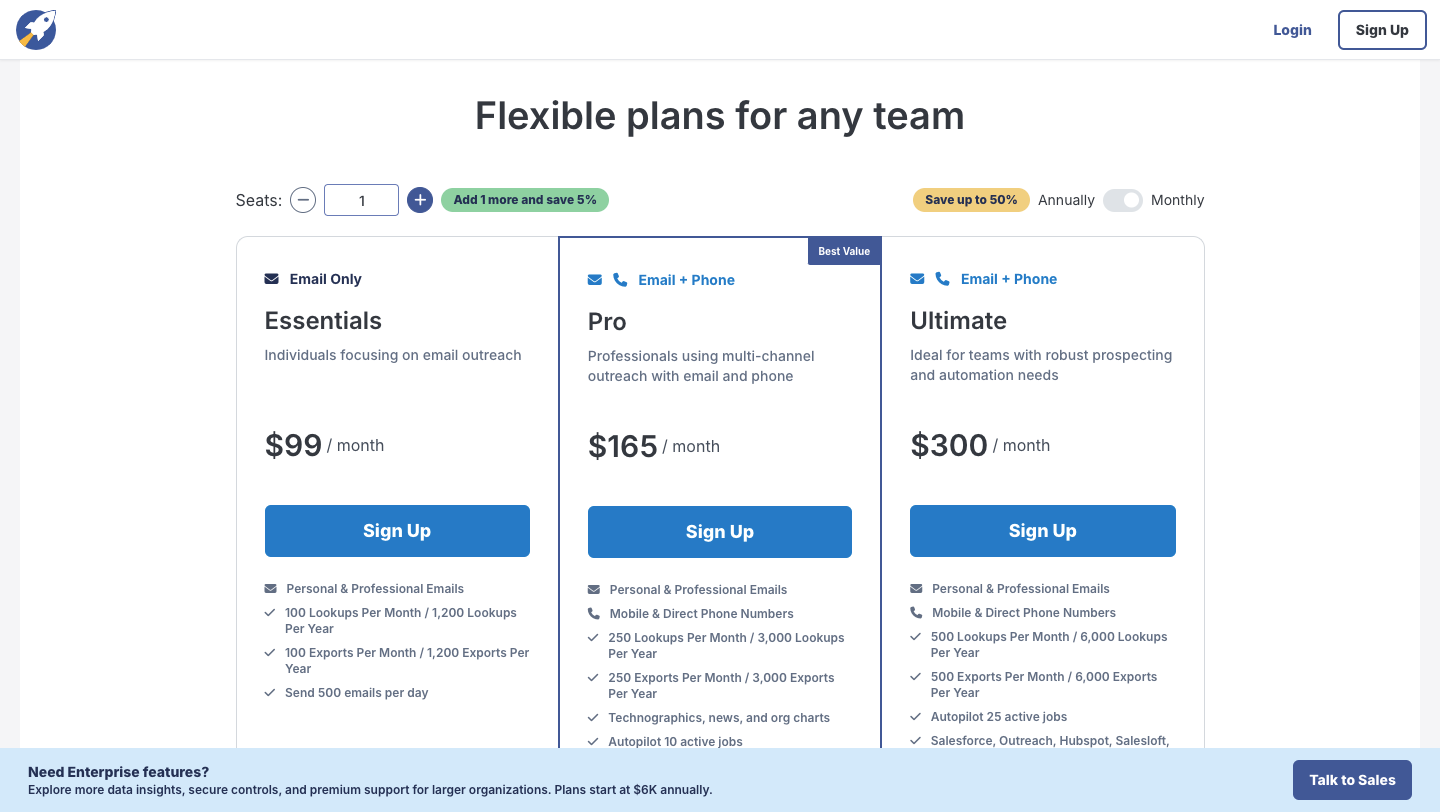
- Transparent pricing: Starts at $99/month. Pricing is public and easy to model.
- Credit-based plans: Costs scale based on usage (lookups), not users.
- No forced bundles: You only pay for contact data — no extra charges for workflows or integrations.
- Not designed for ops teams: Lacks the features RevOps needs to justify scaling.
RocketReach is cost-efficient for tactical outreach, but not built to grow with your GTM infrastructure.
Verdict
RocketReach is the clear winner on affordability and transparency.
But ZoomInfo packs serious depth — if you can afford it and fully activate the stack. Default strikes a balance, offering automation-rich value without the enterprise tax.
Ease of use
Your GTM tech stack only delivers ROI if people actually use it. That’s why usability isn’t just a UX concern — it’s a RevOps performance issue. Here’s how the two tools compare.
ZoomInfo
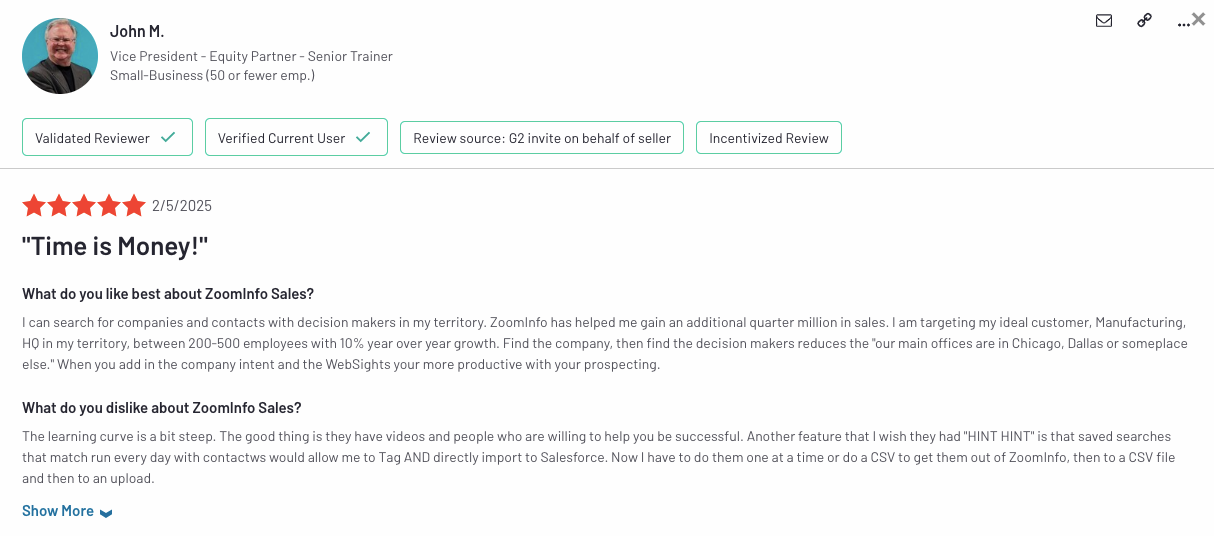
- Steep learning curve: Navigating filters, workflows, and data views requires ramp time.
- Heavy onboarding lift: Most teams rely on internal documentation or ZoomInfo University.
- Non-intuitive UX: Tasks like segmenting by tech stack or intent require multiple steps — not built for quick actions.
- Admin overhead: Managing seats, integrations, and sync behavior often requires a dedicated ops owner.
ZoomInfo pays off when paired with mature processes and dedicated ops. For scaled GTM teams, it’s a serious engine — if you can keep it running.
RocketReach
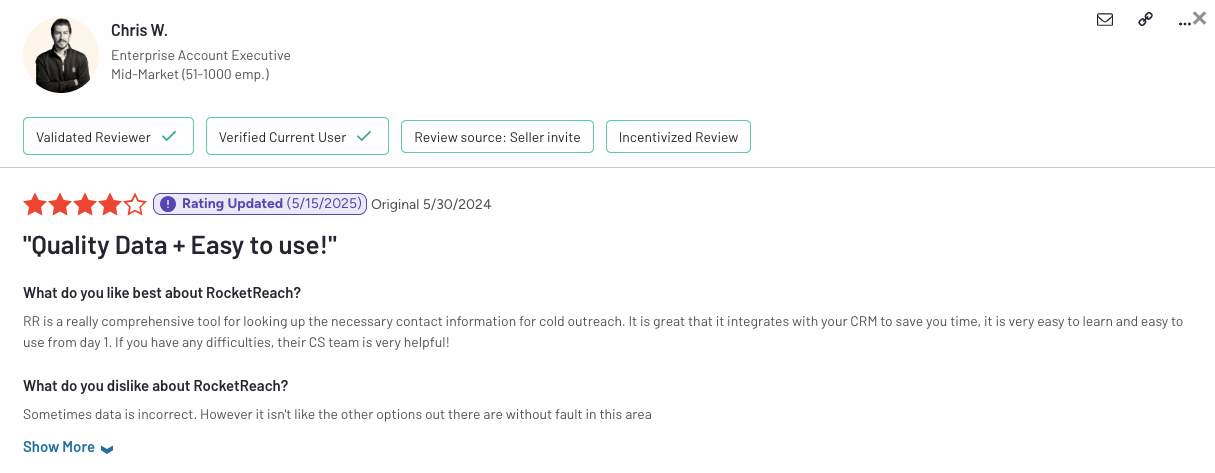
- Instant usability: Chrome extension and lookup interface are simple enough for ICs and founders.
- Minimal setup: No CRM mapping, routing logic, or field mapping required.
- Built for solo users: Great for scrappy outreach — but lacks features for team governance or funnel integration.
- No need for ops intervention: SDRs can self-serve without risk of misconfiguration.
RocketReach is easy because it’s limited — but that may be exactly what you want.
Verdict
RocketReach wins on speed and simplicity — ideal for teams that value speed over structure.
ZoomInfo brings serious horsepower, but comes with a setup cost.
Default lands in the middle: fast to deploy, flexible to scale, and built for inbound from day one.
Customer support
When your GTM engine is moving fast, support delays cost pipeline. Whether you’re onboarding new reps or debugging routing failures, you need more than a help doc — you need outcomes.
ZoomInfo
- Dedicated CSMs (on higher tiers): Ideal for teams with complex workflows or custom integrations.
- Structured onboarding: Access to ZoomInfo University, playbooks, and success planning.
- SLA-backed responses: Enterprise customers get prioritized ticket handling, critical for sales SLAs.
- Ops-heavy model: Support is optimized for scaled orgs — but smaller teams may feel deprioritized.
ZoomInfo delivers when you’ve got scale — dedicated CSMs, playbooks, and structured onboarding all help. But smaller teams may struggle to get that same lift.
RocketReach
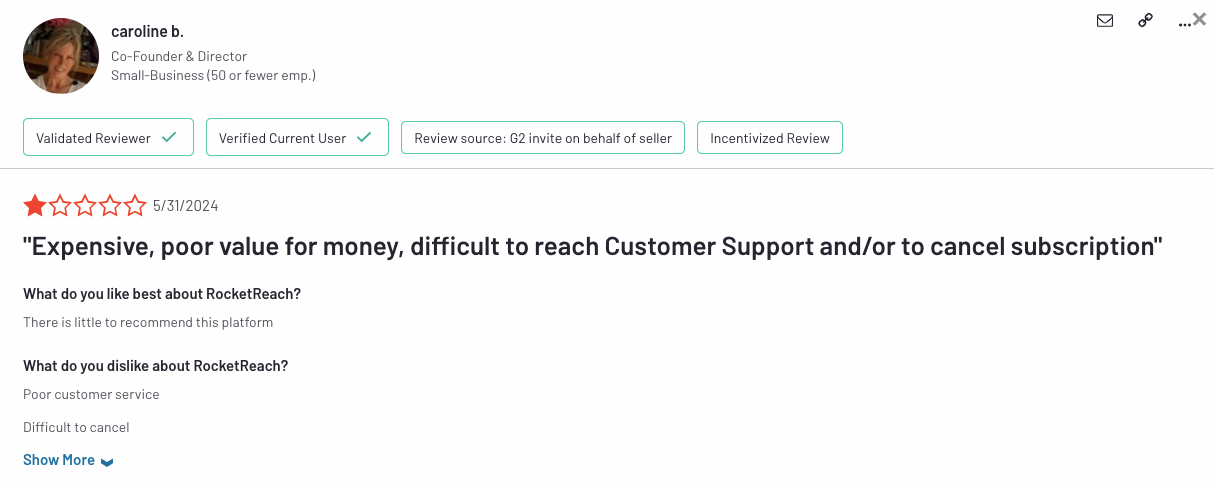
- Email-only support: No live chat or real-time issue resolution. Expect delays.
- Shared reps, no ownership: No named CSMs — even for premium plans.
- Lightweight documentation: Good for how-to questions; not built for onboarding workflows.
- You’re on your own: Which is fine for fast-moving ICs, but limiting once you scale past solo prospecting.
If pipeline speed matters, RocketReach’s support model can become a risk. If a lead gets stuck and there’s no one to help — that’s not a delay, that’s a lost opportunity. When you’re operating with SLAs, shared inbox support won’t cut it.
Verdict
ZoomInfo wins on support — but only at scale. RocketReach is fine for solo users, but GTM teams with SLAs and lead handoff requirements need stronger accountability.
Integrations
Integrations don’t just save time — they make or break your funnel logic. For RevOps teams automating lead flow, sync reliability, and real-time access aren’t optional — they’re pipeline-critical.
ZoomInfo
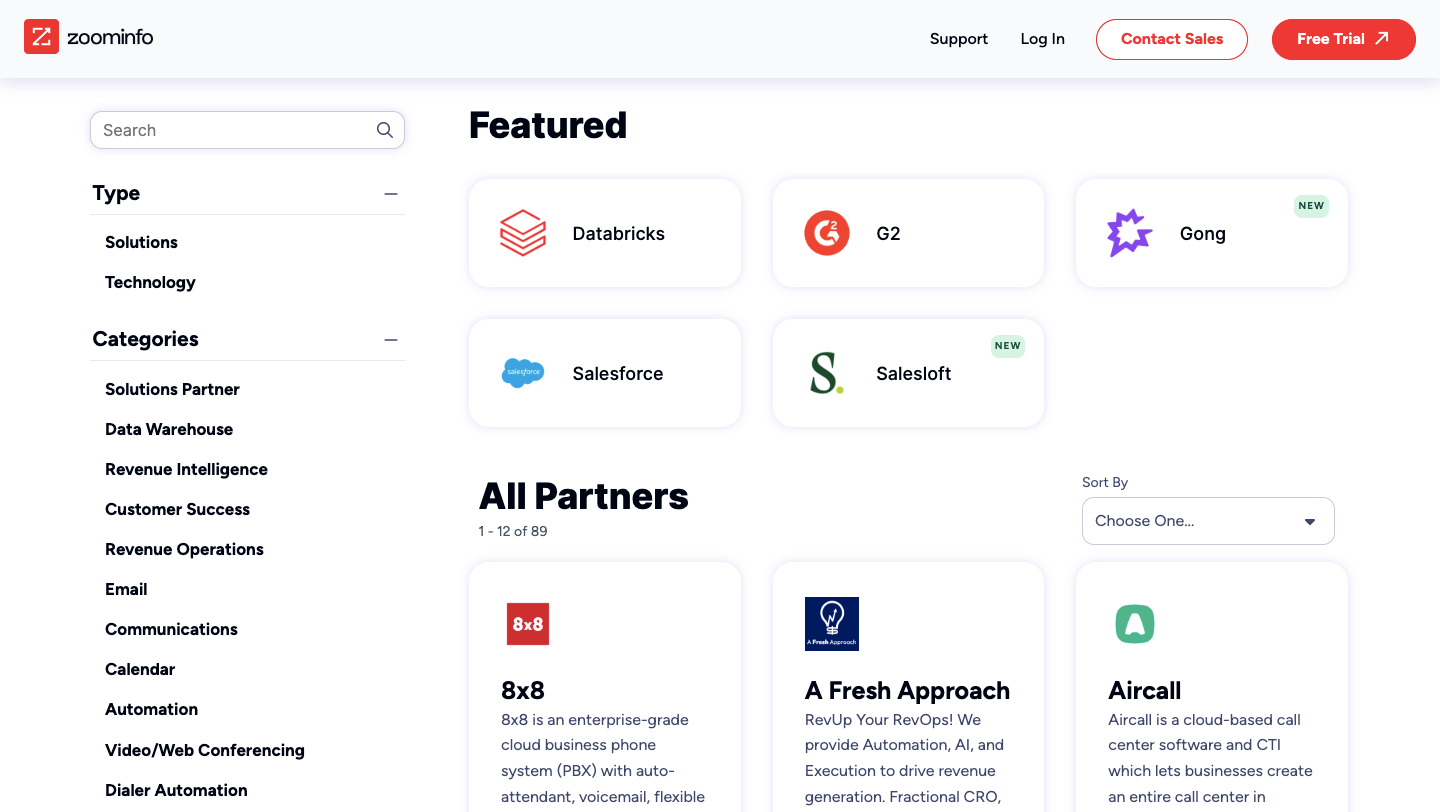
- Deep CRM sync: Salesforce and HubSpot integrations support two-way data flow, with advanced mapping options.
- Multichannel orchestration: Native hooks into Outreach, Salesloft, Eloqua, Marketo, and more.
- Automation engine (Workflows): Trigger updates, route leads, and enrich fields — directly from behavior or intent signals.
- Custom API access: Full control for ops teams with engineering resources.
ZoomInfo is a RevOps-native platform — if your stack is built for it.
RocketReach
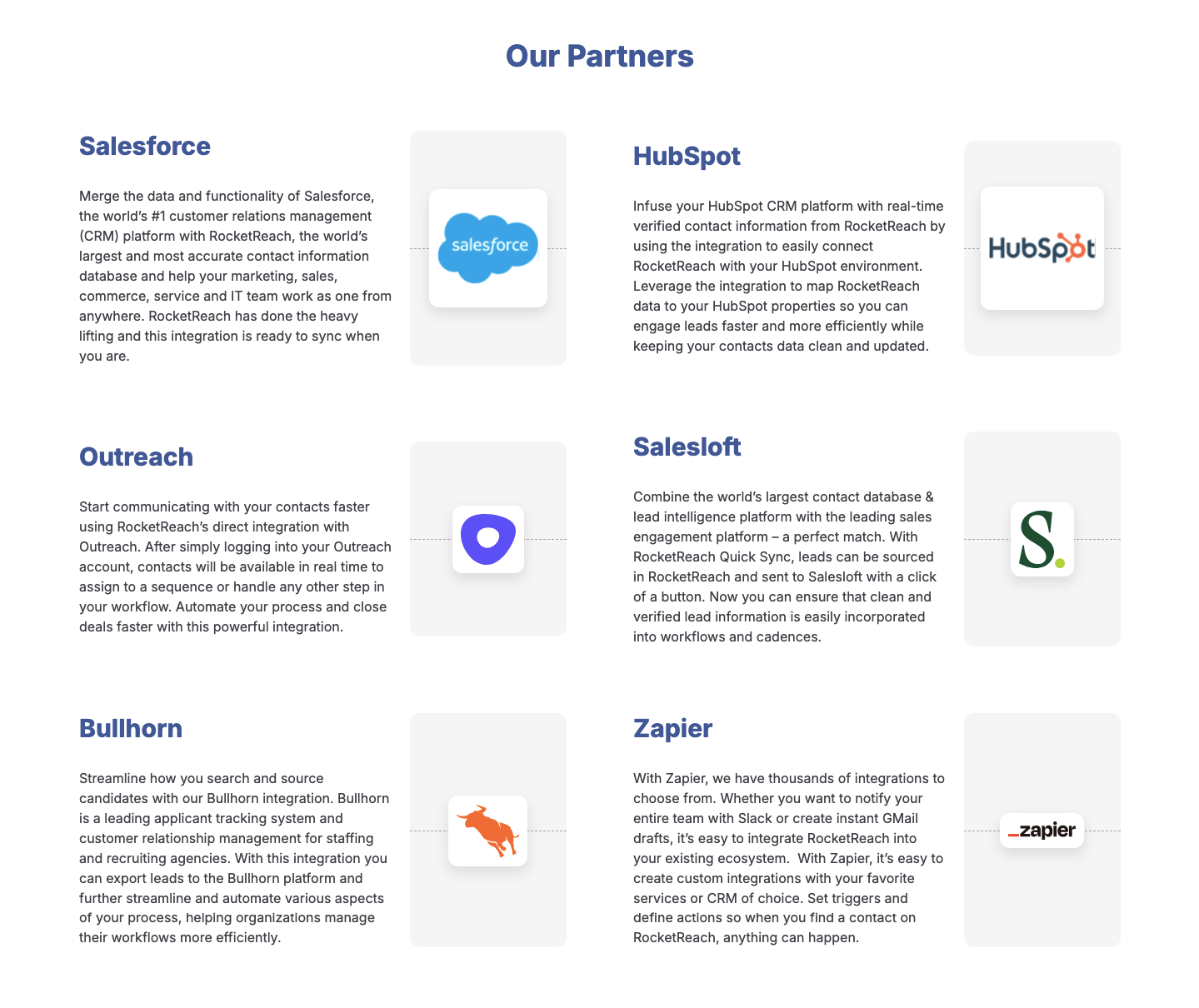
- Limited native integrations: Offers some basic integrations like Salesforce, HubSpot, Outreach, and Zapier — but lacks advanced workflow capabilities..
- Zapier-dependent: Custom logic requires third-party tooling and maintenance.
- Manual exports common: CSV workflows remain the fallback for many teams.
- No routing or enrichment triggers: Can’t act on lead behavior or CRM changes.
When lead routing depends on five tools talking to each other, one broken sync can cost you a meeting — or worse, a deal. RocketReach doesn’t cover that ground.
Verdict
ZoomInfo is built to integrate across a full GTM stack.
RocketReach can sync contact data, but if your team wants real-time routing, behavior-based workflows, or CRM-native enrichment, it’s not built for that job.
Features
Your enrichment tool isn’t just about data, it’s about how that data activates your GTM motion. These aren’t checklist features. They’re pipeline enablers — or blockers.
ZoomInfo
- Intent + Scoops: Real-time buying signals help prioritize outbound and align SDRs around active accounts.
- Advanced enrichment: Append and normalize lead data automatically — native to Salesforce workflows.
- Org charts: Identify decision-makers, influencers, and buying groups to map multi-threaded deals.
- Workflow automation: Set triggers for routing, alerts, and lifecycle stage transitions.
- List segmentation: Create precise, filter-based lists for targeted outreach, ABM, and campaign building.
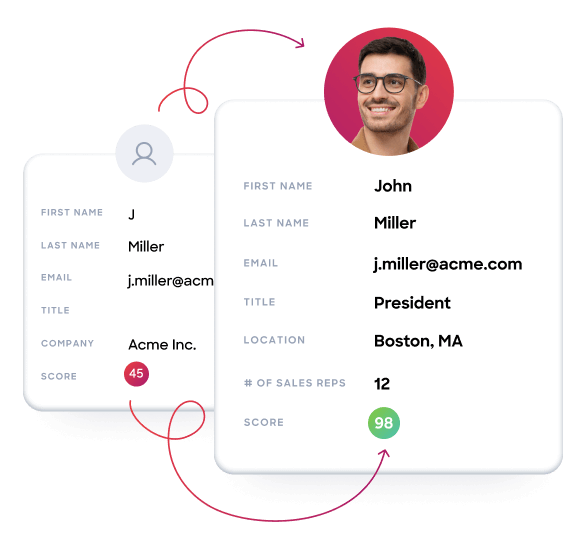
ZoomInfo is built to power structured GTM operations, but requires process maturity to activate fully.
RocketReach
- Verified contact data: Email, phone, and social details pulled directly from profiles or domains.
- Chrome extension: Instant enrichment on LinkedIn or company sites — great for SDR speed.
- Basic filters: Role, company size, and geography — limited firmographic and technographic depth.
- No triggers or workflows: Manual exports and one-time lookups dominate usage.
- CRM sync is shallow: Only the fields you map manually will transfer — no enrichment on behavior or lead scoring.
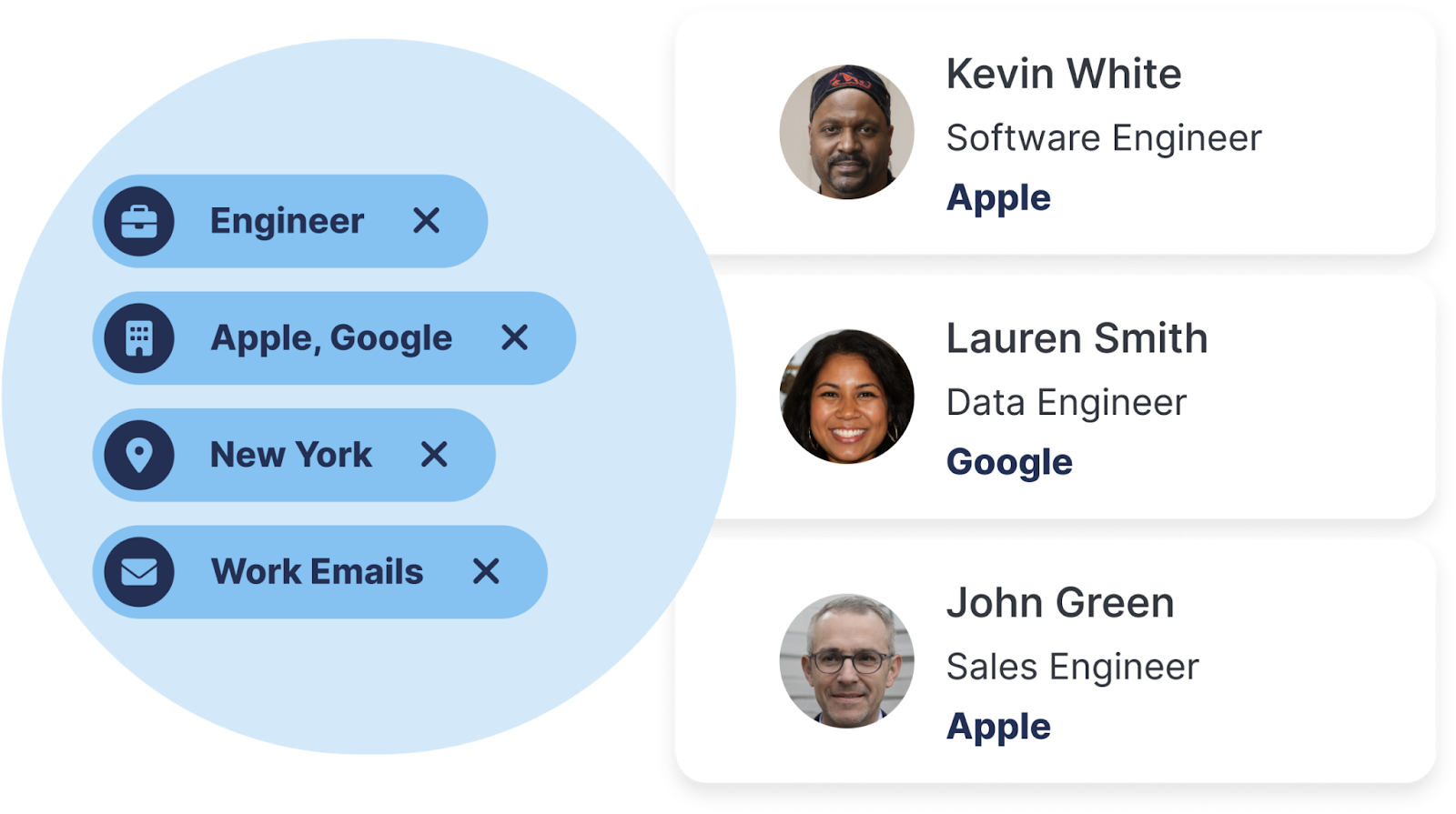
RocketReach is built for contact lookup and list building — not for end-to-end lead flow. And that’s okay, if that’s all you need.
Verdict
ZoomInfo offers depth — but demands ops rigor.
RocketReach offers speed — but sacrifices structure.
Neither solves for end-to-end pipeline flow. That’s where a unified platform like Default stands apart.
How to choose the best data enrichment software
Choosing a data enrichment platform isn’t about checking boxes — it’s about closing gaps.
Too many tools enrich… but don’t convert. They give you data, but not velocity. If you're running an inbound GTM motion, these are the three things that matter most:
#1: Real-time CRM-native enrichment
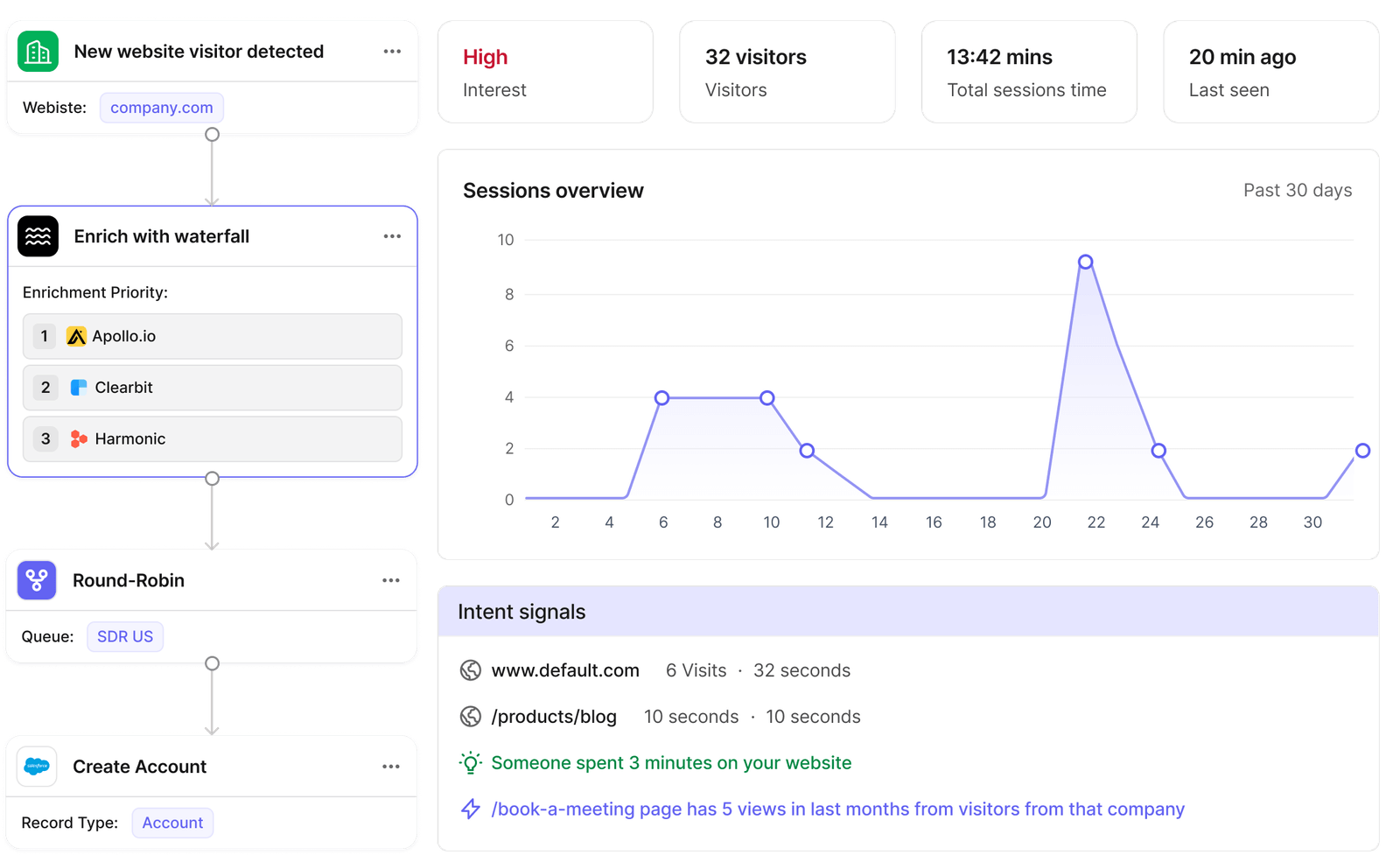
If your leads are still being enriched via CSV or delayed syncs, you're bleeding time. Real-time, in-CRM enrichment is the difference between a rep following up in seconds vs. hours.
Default is built to enrich directly inside Salesforce and HubSpot — no delays, no batch jobs.
Book a demo to see leads enriched before reps even open a record..
#2: Enrichment that flows into routing and scheduling
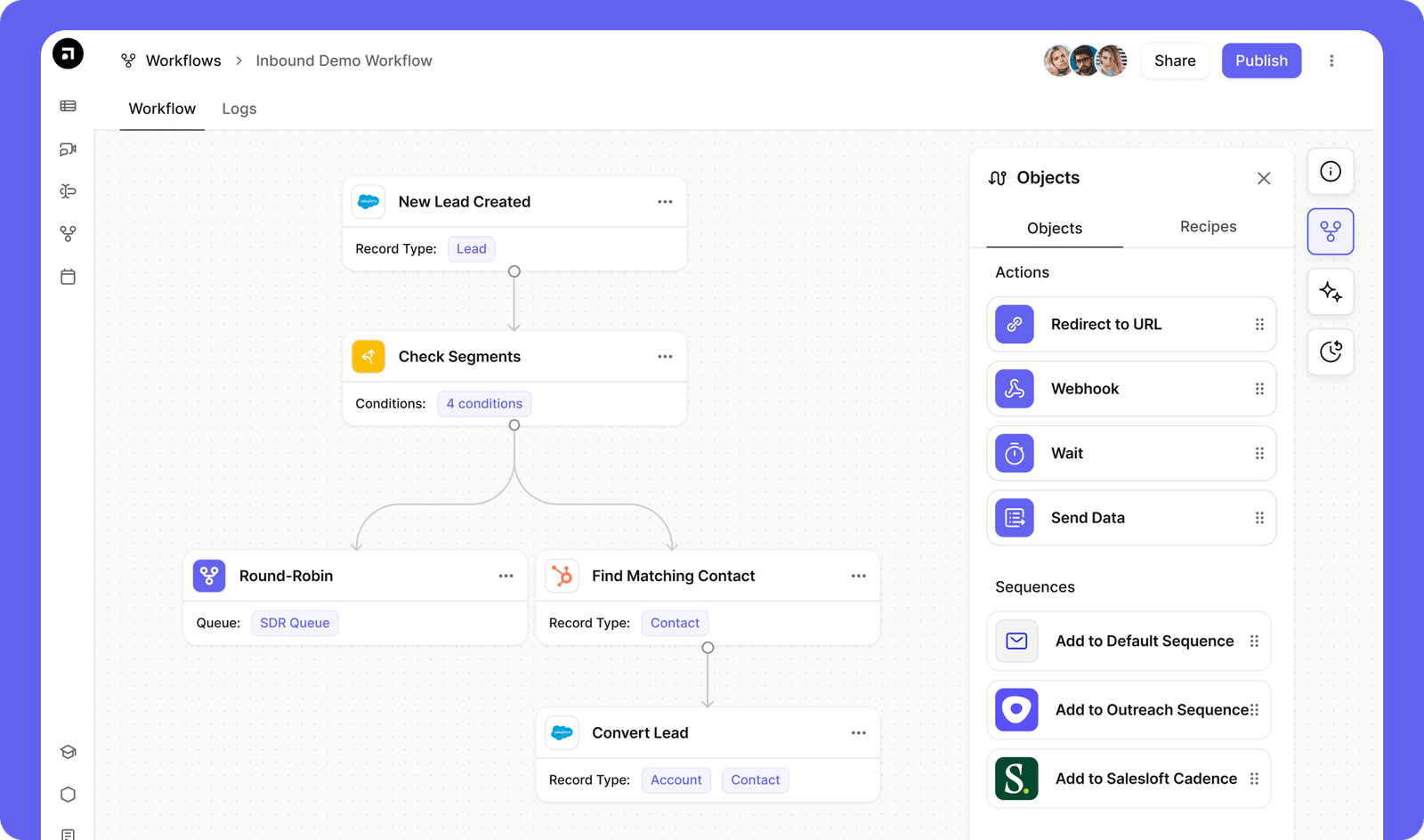
A full lead record is useless if it just sits there. Look for tools that trigger assignment and booking based on logic your ops team owns — not bolted-on integrations.
Default connects enrichment with instant routing and scheduling — all in one flow.
#3: Simple ops access and predictable pricing
If every admin or viewer user adds cost, you’ll hesitate to give access — and slow things down. You want clear pricing and clean ownership.
Default only charges for routed users. Everyone else? Included.
Why Default is the GTM system modern teams actually need
Forget cobbled stacks. Default unifies enrichment, routing, and scheduling — with RevOps in control.
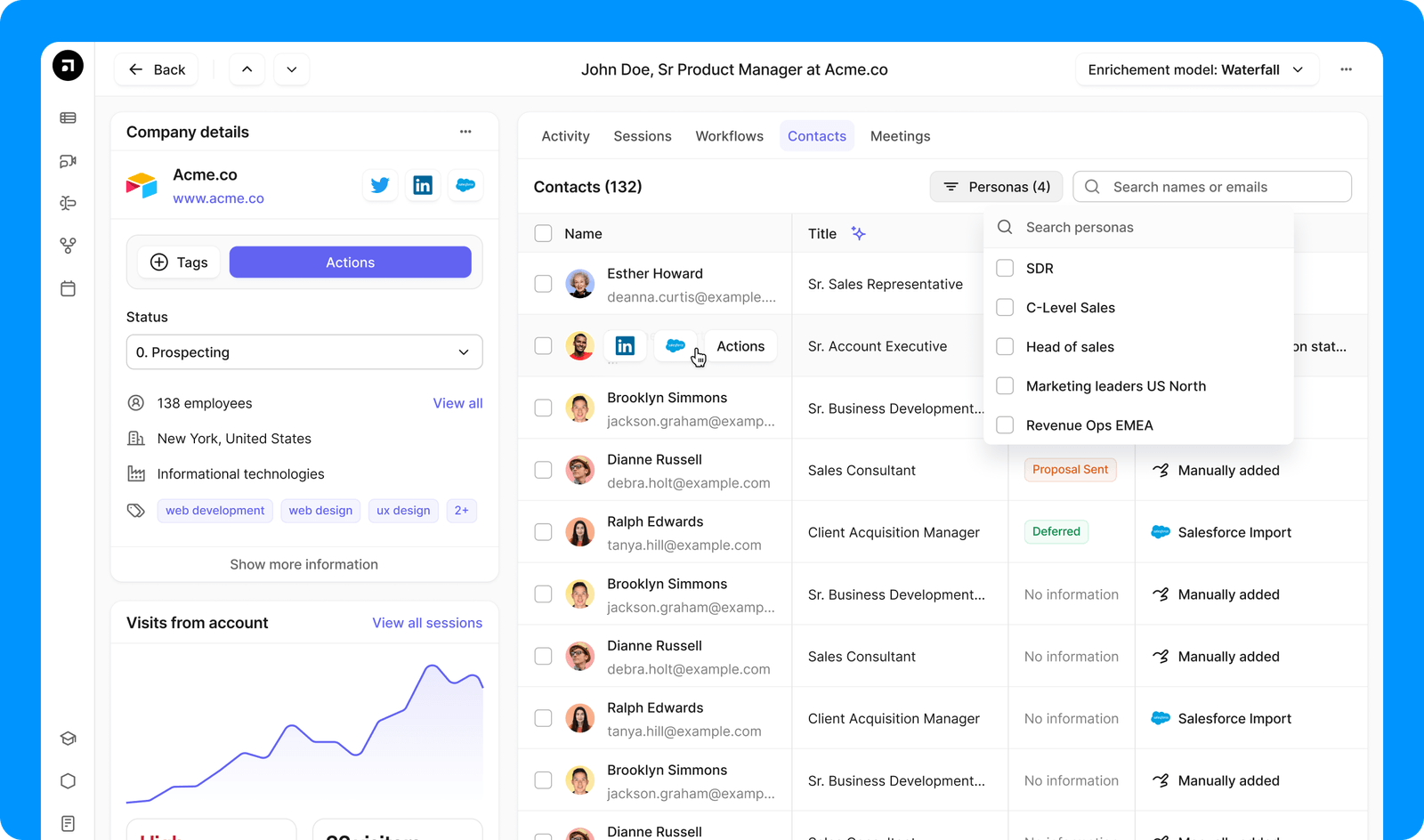
ZoomInfo is built for scale. RocketReach is built for speed. But if your team runs an inbound motion — and wants every lead enriched, routed, and scheduled in seconds — you don’t need more tools. You need one system that does the job.
Default is that system.
It replaces the cobbled-together tech most RevOps teams rely on: enrichment via Clearbit, routing via LeanData, scheduling via Chili Piper. That stack is expensive to maintain, hard to scale, and fragile under pressure.
Default unifies all of it — into one CRM-native, ops-friendly flow.
Key features
#1: Real-time CRM enrichment
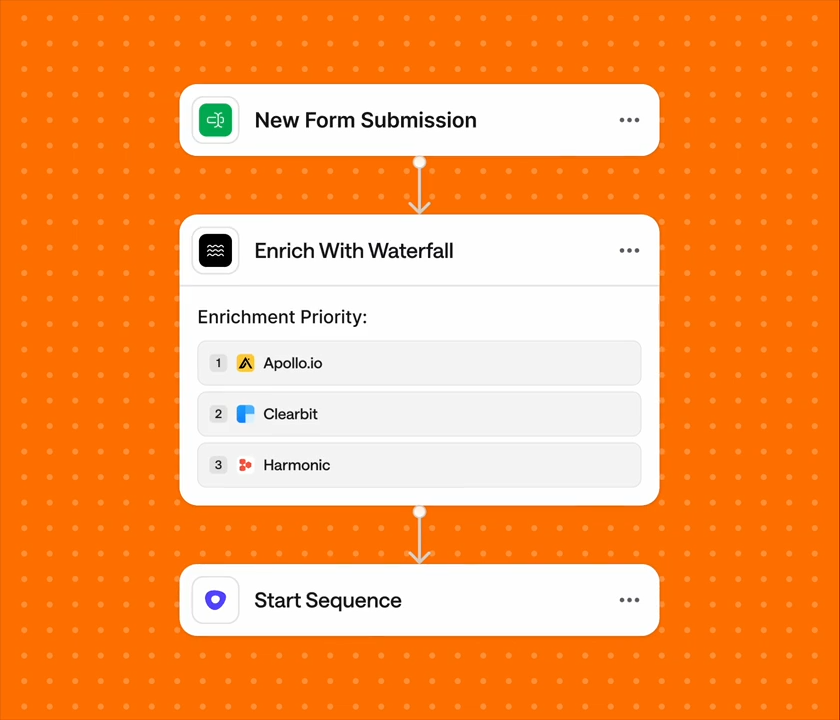
Enrichment isn’t helpful if it shows up late or dirty. Default enriches every new contact or account as they enter your funnel — with firmographic and technographic data from a 400M+ record source.
It maps directly into Salesforce or HubSpot fields with no delay, no API stitching, and no batch syncs.
#2: Workflow-native lead routing
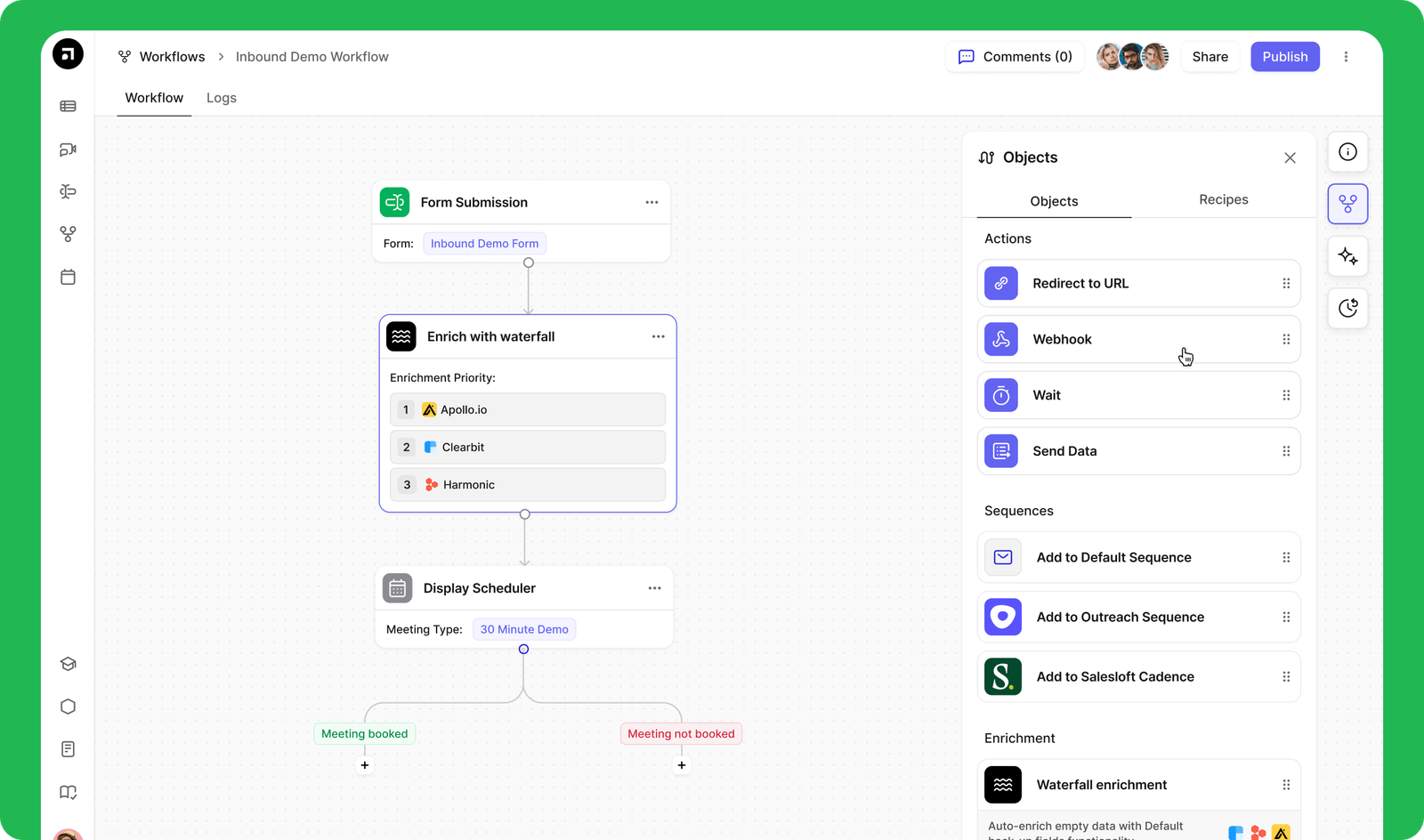
Default lets RevOps teams build if-this-then-that routing logic based on segments, territories, round-robin rules, and rep capacity — all without needing engineering support.
Assignments trigger CRM ownership updates, Slack alerts, and downstream actions — automatically.
#3: Instant scheduling embedded in flow
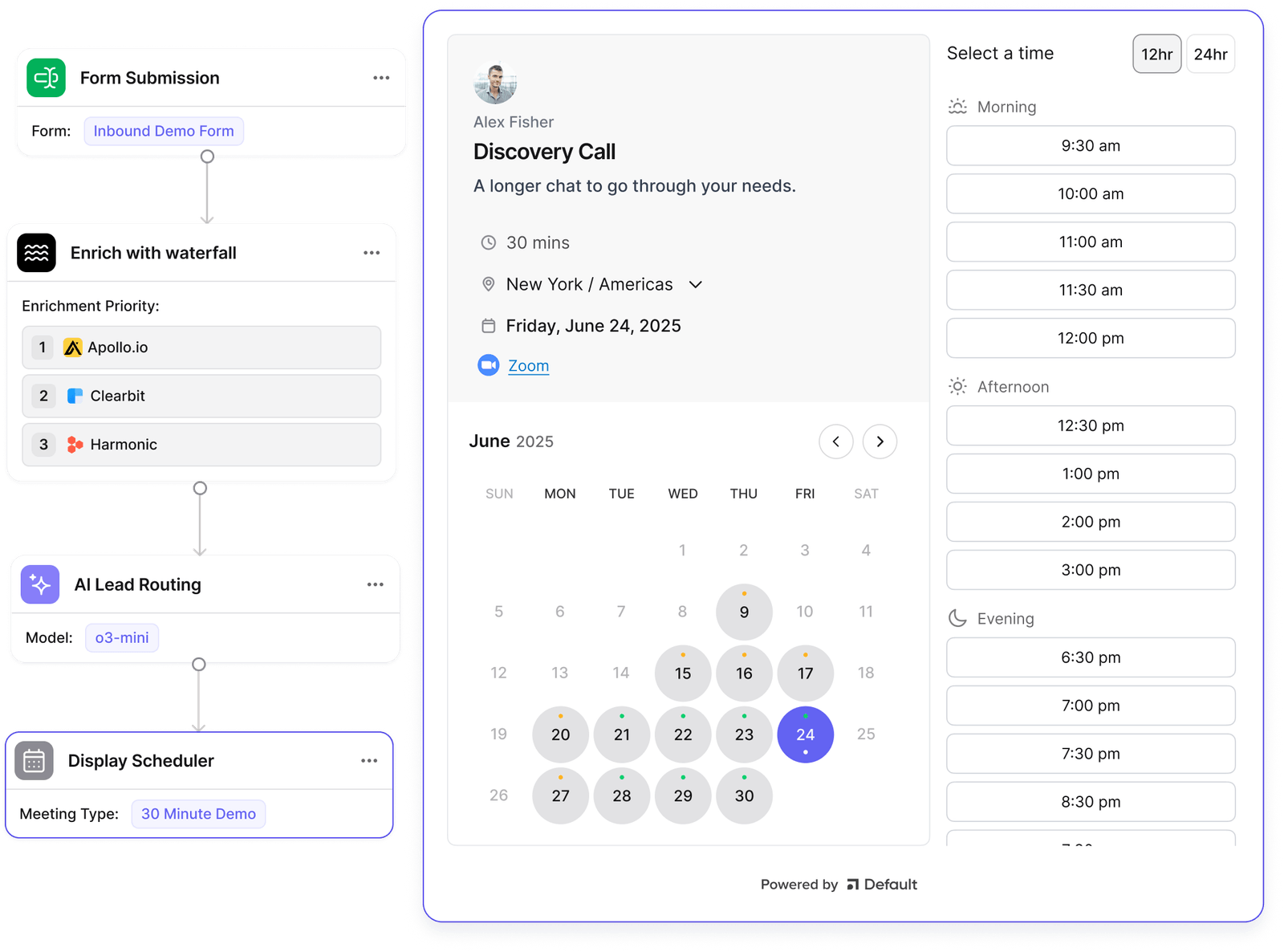
Post-form, qualified leads get routed and shown a personalized scheduler — not a generic calendar link. Default books meetings based on availability and ownership logic already set in your workflows.
This means no redirects, no tool-switching, and no dropoff.
Pricing
Where Default shines
- Unified GTM funnel: No more point tools. Enrichment, routing, and scheduling live in one system — fully connected.
- RevOps-first control: Territory logic, lead assignment, CRM mapping — all configurable without engineering.
- Transparent, predictable pricing: No per-seat creep. Only routed users trigger cost.
Where Default falls short
- Not a prospecting tool: Default doesn’t offer bulk lead lists or scraping tools — it’s focused on inbound conversion, not top-of-funnel volume.
- No third-party intent (yet): Unlike ZoomInfo, Default doesn’t offer Bombora-style signals.
Customer reviews
“Our entire inbound engine runs on default.com, and we can't seem to imagine why anyone would not use this as a core tool in the marketing/sales stack! The product fixes every possible problem you could imagine when handling inbounds - be it qualification, routing or tracking.” - Pankaj S., verified G2 reviewer
“I love not having to manually send out Calendly links in sequences or emails, and then determine who to route the lead to. With a one-time setup, we can easily route leads more efficiently and leverage the tool for all of our inbound sales leads.” - Will T., verified G2 reviewer
Who Default is best for
- RevOps teams scaling inbound: Especially those tired of duct-taping systems together
- Inbound GTM motions: Where speed-to-lead, qualification, and handoff timing impact conversion
- Mid-market to Series B+ companies: Looking to automate without adopting legacy platform overhead
Stop stitching tools. Start moving faster.
If you’re scaling an inbound funnel, stitching together enrichment, routing, and scheduling just slows you down.
Every extra tool adds complexity. Every manual step risks lead decay. Every ops workaround becomes a bottleneck.
Default replaces the patchwork with a system — one your RevOps team can own from end to end.
- Leads get enriched inside your CRM, instantly.
- Routing happens based on logic you control.
- Scheduling just works — no links, no redirects, no delays.
No middleware. No handoffs. No engineering tickets.
If you’re serious about pipeline speed and operational clarity, it’s time to move past legacy stacks.
Try Default free for 14 days. Book your live demo to see how fast inbound can really move (no Zapier magic tricks needed…)
Conclusion

Former pro Olympic athlete turned growth marketer! Previously worked at Chili Piper and co-founded my own company before joining Default two years ago.
Accelerate your growth with Default.
Revamp inbound with easier routing, actionable intent, and faster scheduling















.png)


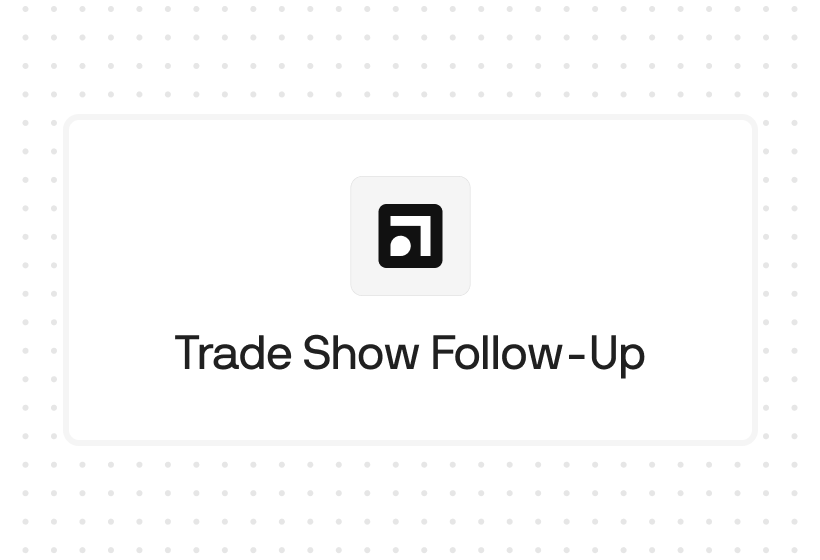
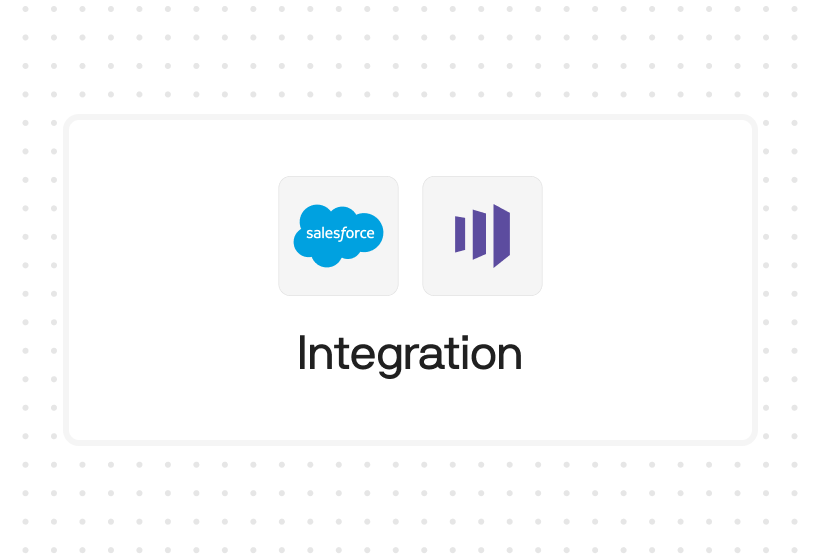




%201.svg)



.svg)





%201.svg)



%201.svg)

